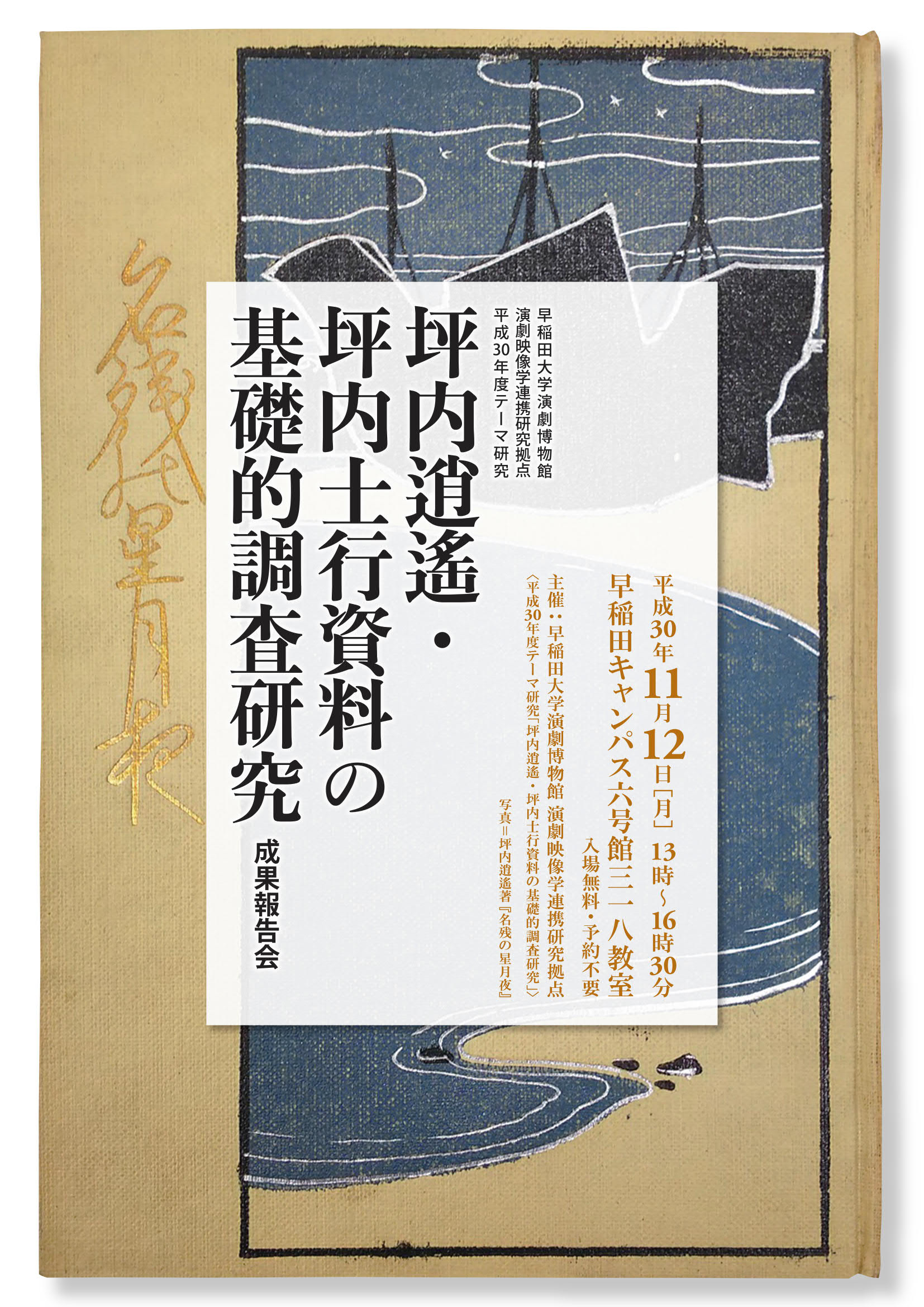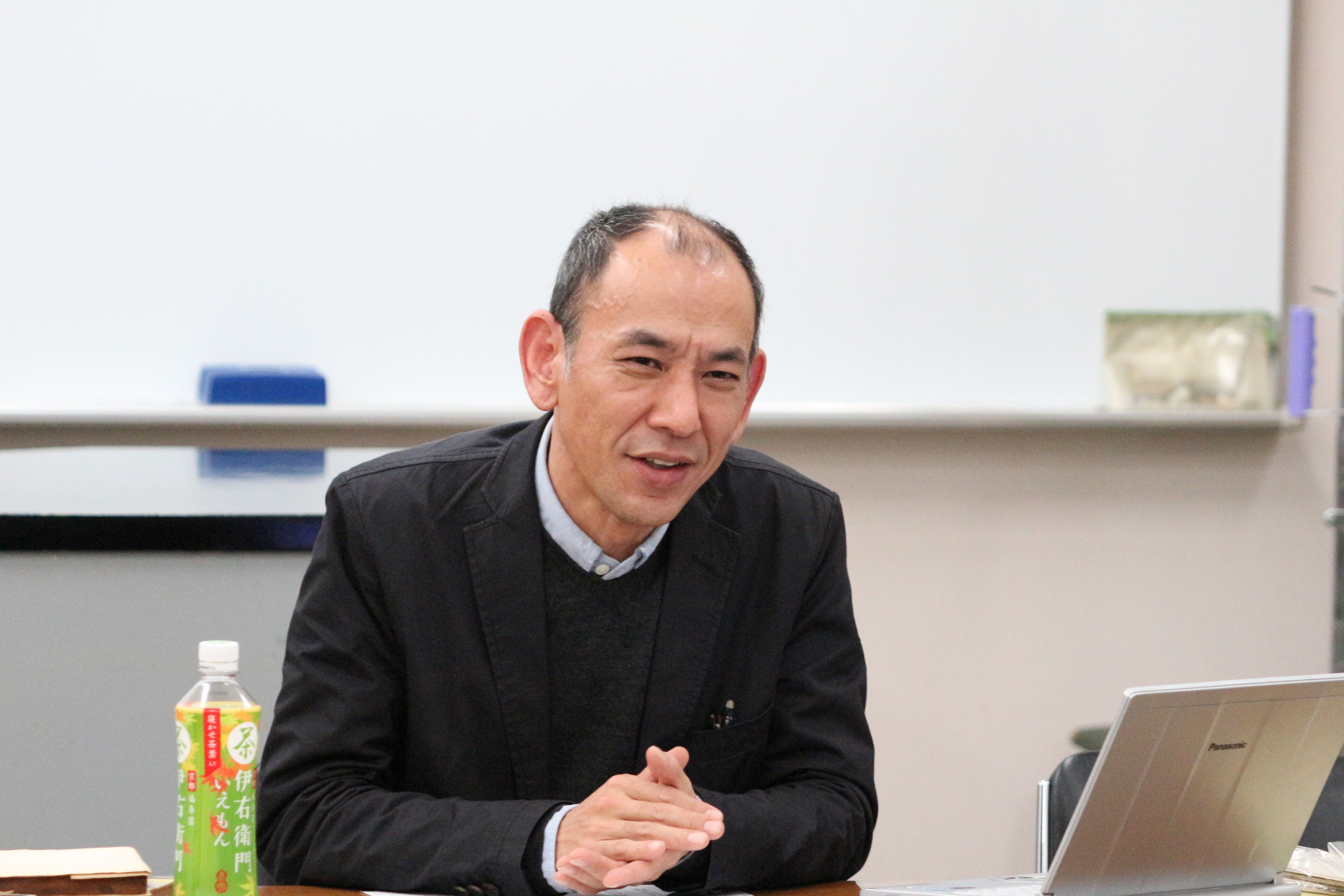Report on the Activities of the Joint Research Teams
Fiscal 2018
In 2018, the joint research teams compiled their findings and made their presentations. The following section introduces some of their activities.
Principal Research 1
Basic research survey of materials relating to Shoyo Tsubouchi and Shiko Tsubouchi
A conference was held on November 12, 2018, to report the results of this research team’s investigation and study of unsorted materials related to Shoyo Tsubouchi (Shoyo) and Shiko Tsubouchi (Shiko). Five members of the research team conducted presentations.Kaho Mizuta reported on a lecture plan from thelate-Taisho period owned by the late Shiko, showing stage photographs of the Gikyoku Kenkyukai societyand discussing the new form of Japanese theater for which Shiko advocated. Kaoru Matsuyama analyzed the content of seven letters from Daigo Ikeda to Shoyo,referencing them against Shoyo’s diary and conductinga concrete investigation of Daigo’s Mumeikai-era activities, the Gekidan-kai, the process of creating Meigetsu hachiman matsuri, and his relationship with Shoyo. Kazuko Yanagisawa used letters to trace the relationship between Shoyo and Sekkyo-bushi performer Wakatayu Wakamatsu which began with a Tokyo Kuruma-ningyo performance. Yanagisawa also investigated materials such as the two men’s diaries.Kuniko Hamaguchi discussed the relationship between Shoyo and Nagoya-based Nishikawa-style dancer KagiNishikawa (Kagi Oda), a distant relative of Shoyo’s,as well as Kagi’s death, the dance performance at her memorial, and letters to Shoyo from Shiko’s younger sister, Shizu Oda. Finally, Tomoaki Kojima discussedin detail the interaction between Matsutaro Ishiwari,Shoyo, and persons at Waseda University based on letters, Shoyo’s diary, and memoirs. Kojima considered the time and motive of when a research study on Ningyojoruri (puppet theater) was started.This research team has sorted and photographed materials related to both Shoyo Tsubouchi and Shiko Tsubouchi, and is proceeding with research on this basis. We have been able to publicize various facets of our research and to hold what proved to be a meaningful conference.


Left: Flyer, Right: Presentation by Tomoaki Kojima
Selected Research 1
Research on musicians and musical bands regarding Kurihara’s musical score collection : music for stage and cinema during the early-Showa era
On January 30, 2019, this research team held apublic conference based on an investigation of materials owned by Shigekazu Kurihara, who played in Ken’ichi Enomoto’s band. During the first half of the conference,Fumito Shirai and Yohei Yamakami reported the results of their investigation of score materials, and a research associate at the center, Kotaro Shibata, conducted apresentation on Kurihara and his musical activities atthe Asakusa Nihon-kan movie theater. Masaaki Nakano made a research presentation on the adaptations of Ken’ichi Enomoto’s comedy shows, and Makiko Kamiyagave a research presentation examining the significance of Enomoto’s films in the history of Japanese cinema.Comments by Midori Takeishi and a panel discussion by the speakers also shed light on specific subjects such as musical performance and song selection, as well astheir involvement in the diverse activities of Enomoto,including plays, revues, and films. During the second half of the conference, in addition to an introduction and analysis of SP recordings by Masato Mori, specialist of the SP records of the time, a seven-person band led by saxophonist and clarinetist Kyoichi Watanabe performed compositions selected from Kurihara’s materials. Music of Kurihara, who was an early adopter of the new repertory of the time, was vividly resurrected thanks tothe band’s reproduction of characteristics such as the rich, harmonious saxophone tone that accompanied Enomoto’s original performances. This proved to be a meaningful conference that has spurred development of future research, such as further study of score materials and investigation of contemporary documents.

Left: Flyer, Right: Discussion at the Symposium
Selected Research 2
Understanding the Studio System in Postwar Japanese Cinema : Empirical Research on Nikkatsu Roman Porno
On December 22, 2018, a conference titled “Nikkatsu Roman Porno Interpreted Through Press Sheets” was held at Waseda University’s Toyama campus. First,Michiko Usui explained the general outline of the team’sproject and the purpose of the conference, touching on topics such as the definition of “press sheets” and the idea of the “studio system” within the context of Japanese cinema, a topic that is also a research project theme. Also in the first part of the conference, Keisho Kihara gave a general outline of the press sheets held by the Theatre Museum, including graphs showing thetotal number of sheets, their distribution by year, and other details. Next, Mio Hatokai presented a case study of the use of promotional materials such as press sheets,posters, and newspaper advertisements using Sukebankeiji Dirty Mary (1974) as an example.
In the second part of the conference, Naoya Naritaand Tomoko Saotome, who were responsible for the production and promotion of Nikkatsu Roman Porno,took part in a roundtable discussion with Jinshi Fujiiand Hatokai serving as interviewers. Narita, who had worked as a producer at Nikkatsu Corporation during the Roman Porno period, discussed the background of films for which he was responsible, such as the Tenshino harawata series and Love Hotel (1985); similarly,Saotome explained how taglines and summaries on press sheets were written/created, as well as how they were used in advertising, with reference to specific episodes.There has been little testimony concerning the distribution and exhibition of Roman Porno, and such information is not well-known even among film researchers. Although press sheets are available, almost no prior film studies research have used these materials.This event, which intended to approach press sheets from a variety of angles, should provide a fresh point of departure for future studies.


Left: Flyer, Right: The public conference
Selected Research 3
Restoration of the works of Rissho Katsuei Film Company based on multi-materials
“Discovery and Research: Religion and Film” at theKobe Discovery Film Festival 2018 was held with the joint sponsorship of the Kobe Planet Film Archive Executive Committee. At the event, representative Manabu Ueda presented the results of a joint research project that examined the history behind the production of Nabekaburi Nisshin (1922) and Shaka no shogai(1961), as well as the surviving film; in addition,his collaborator, Yulia Burenina, gave a research presentation on 1920s Nichiren Buddhism and Nisshin.This event also included a screening of digital materials of these films; in particular, the screening of NabekaburiNisshin garnered the attention of many audience members because this film was thought to be lost.
Selected Research 4
Visual depictions of Chinese theater and Taisho period Japan : focusing on Nobuyo Fukuchi ’s Shina no Shibai Sukecchi-cho
On October 23, 2018, a speech and performance sponsored by the Waseda University Theatre Museum’s Collaborative Research Center for Theatre and Film Arts,titled “100 Years of Kun Opera and Japan,” was held at the Okuma Auditorium.
This event was held in response to a request from the Shanghai Kun Opera Troupe on a visit to Japan,who desired to hold a promotional event at Waseda University for their performances of “Kunju zoujinxiaoyuan” all around the country. This request was accepted and fulfilled by the Waseda University Theatre Museum’s Collaborative Research Center for Theatre and Film Arts and its joint research team.
This year, in 2019, will be the 100th anniversary of the first Japanese performance by Chinese actor MeiLanfang, world-renowned for playing female lead roles.Mei, who has deep ties to Waseda University, held several Chinese Kun opera performances in Japan, whichwere the first times people had ever seen such opera performed on a Japanese stage. This event provided an opportunity to look back on Japan’s relationship with Kun opera initiated by these performances, featuring the Shanghai Kun Opera Troupe’s performance of “Yuzanji:qintiao,” which Mei performed on his visit to Japan.
On the day of the event, a long line of attendees formed outside Okuma Auditorium, and ultimately more than 600 people attended the event. Professor Norikazu Hirabayashi of Waseda University explainedthe meaning of the title “100 Years of Kun Opera andJapan,” after which Gu Haohao, leader of the Shanghai Kun Opera Troupe and director of the Shanghai ChineseOpera Arts Center (which plays a leading role in the Shanghai traditional performing arts world) gave a talkon Kun opera and the Shanghai Kun Opera Troupe.
In the second part of the conference, coordinator LuHairong commented on the program and guqin player Yang Zhijian, who had accompanied the troupe to Japan, discussed the history of Sino-Japanese exchange through the guqin (koto in Japanese), then performed the famed piece “Gaoshan liushui.”
Next, three Kun opera plays were performed,including the tempestuous swirling movements of QianYuting’s Hu Sanniang in Hujiazhuang and Wu Shuang’shumorous performance as Lu Zhishen and the liquor merchant in Hunangdan: shanting.In the third play,“Yuzanji: qintiao,” the audience breathlessly observed the longing of the student and the nun for one another,played by Li An and Chen Li, respectively, as expressed through the playing of a lute.
Finally, Gu Haohao and Theatre Museum director Minako Okamuro exchanged thank yous and mementos,and be fitting an event commemorating the 40th anniversary of the conclusion of the Treaty of Peace and Friendship between Japan and China, the 90th anniversary of the founding of the Theatre Museum,and the 40th anniversary of the founding of the Shanghai Kun Opera Troupe, the curtain closed amid an atmosphere of harmony.



